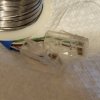NETGEAR 8 Port PoE Gigabit Ethernet Easy Smart Managed Essentials Switch (GS308EPP) - with 8 x PoE+ @ 123W
Am running the above switch.
I would like to run 2 Daiwa 5442’s without running 2 separate ethernet cables from the switch to each cam. So the idea of a 2 port splitter comes to mind. How about a 3 port splitter to give some optionality for future installs? Will that work with my switch?
Which one will work for my intended use? I don’t see any name brand companies selling such a product. TrendNet has one for about $60 which seems pricey for what it does. I see YuanLey and other Chinese brands for around $20 and change on AMZN.
Any recommendations, mindful of power requirements, which will work for my cams?
Am running the above switch.
I would like to run 2 Daiwa 5442’s without running 2 separate ethernet cables from the switch to each cam. So the idea of a 2 port splitter comes to mind. How about a 3 port splitter to give some optionality for future installs? Will that work with my switch?
Which one will work for my intended use? I don’t see any name brand companies selling such a product. TrendNet has one for about $60 which seems pricey for what it does. I see YuanLey and other Chinese brands for around $20 and change on AMZN.
Any recommendations, mindful of power requirements, which will work for my cams?

